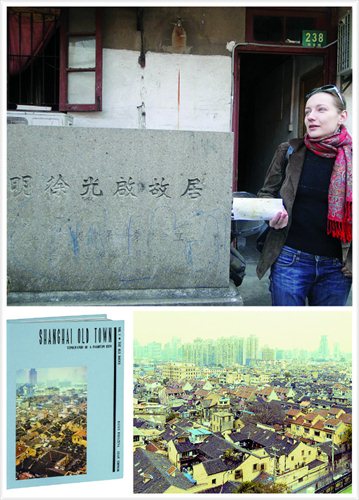Saviour of the city streets
The idea of producing the first English-language guide to Shanghai's original urban core - old town (lao chengxiang), occurred to Katya Knyazeva, a Siberian freelance journalist and photographer, when she started to catalogue the pictures she had taken in the area.
She discovered that no English book or website offered a complete guide to all the remaining antiquities.
For six painstaking years, she researched the area's streets and buildings in reference to vintage street maps, 19th century American and British church journals, and Chinese-language Shanghai history blogs among many other sources. She photographed her subjects using expired film to bring out a scratchy, hazy quality.
Shanghai Old Town: Topography of a Phantom City - Volume I: The Old Docks, which is now available online and local bookstore Garden Books, explores the ancient lanes and historic relics of Dongjiadu, the port outside the city wall. Knyazeva will publish Volume II: The Walled City this fall.
She will also guide Walk: Shanghai Old Town on January 24 (info@historic-shanghai.com).

The Siberian freelance journalist and photographer Katya Knyazeva (top) spends six years researching and photographing Shanghai's vanishing old town area and publishing her first book Shanghai Old Town: Topography of a Phantom City - Volume I: The Old Docks (above left). Photos: Courtesy of the author
GT: Did you intend to divide the project into two parts from the start?
KK: No. At first I thought I'd make one book, then the materials really expanded. Then I decided I would section The Walled City into four parts, plus the area of Dongjiadu Dock. But that would be a very unwieldy project.
I also want to create a momentum that, when one part is finished, there is anticipation for the second part, since this is a self-driven project without any academic guidelines or institutional drive, and self-driven often means very slow.
There was a bit more urgency with The Old Docks because the walled city is still standing, while the docks have been wiped out.
GT: Besides written materials and archives, you also talked to residents. What new ideas and perspectives did you gain from their stories?
KK: The first impression any neighborhood like this leaves you with is "oh, what a beautiful building."
But there are problems. People living there are very often living in very crowded conditions, they are not very happy about having to share facilities, so soon I began to understand not everyone living there wants to stay there. They want improvement. So I came to accept many people living in the old town would rather live in new buildings.
However, one thing I've learnt is that so many people have really deep roots and links to Shanghai. There are people whose last names are in the street names, and many many generations are still more or less in the same place.
What I didn't change my opinion on is that different things could be done rather than taking the old neighborhoods down and building high-end real estate. There are other ways to improve the neighborhoods.
Actually, in the old town in the 1990s there were projects aiming at better-looking, better-preserved lane compounds.
For example, building a third floor could give a little extra space to everyone and massively improve shared kitchens. So, places like this could be treated with a lot more case-by-case, thoughtful touches.
GT: Are there any similar cases in your home country?
KK: I'm from an industrial city that lacks historic buildings. So I was initially pretty insensitive to urban planning and architectural beauty because there was none of that around me. But in my 20s I realized there are nice places and places where history improves and blesses the whole neighborhood.
Moscow is a really nice old town, in a way it could be similar to the former walled city of Shanghai because it has layers and layers of history and very old buildings.
Russia is not as well capitalized as Shanghai is. They don't wipe out blocks on such a massive scale as they just don't have huge investment. In a way, this helps preserve old architecture.
GT: Is there any part of the book that you wish you could have done better?
KK: I wish I got to know this particular neighborhood, Dongjiadu, earlier. I wish I had visited it more thoroughly before it changed so much.
I particularly remember Waimalu, now the Cool Docks, getting revamped. There were a lot of trash recycling factories along the river and I used to bicycle there, but the smell was so bad that I never stopped to take photos. I wish I was a bit more resilient and took care to document this.
GT: Please name some personal favorite spots to visit before they vanish.
KK: It is good to see a building, but it is also even better to see a building before it is thoroughly renovated. Renovation very often takes away all the features of a building and makes it look like a postcard of itself.
In the Old Docks and Dongjiadu area, the cathedral is closed now, and the sea merchant hall is quite the star of the neighborhood. It would be very interesting to visit it before it is turned into something else. They could move it somewhere, but it is not going to be the same building.
You know how it is in Shanghai, so walk in every street you can, because it might not be there tomorrow. As I was writing, street names were gone before I finished.
I thought I was writing a series of guided walks, taking you through the neighborhoods, but in case of Dongjiadu that was too late.
So instead, the first volume became a documentary and an epitaph.